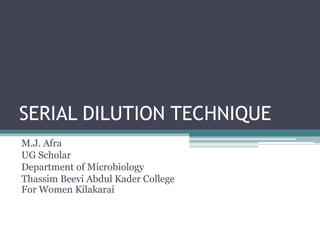
SERIAL DILUTION TECHNIQUE FOR MICROBIAL COUNT
- 1. SERIAL DILUTION TECHNIQUE M.J. Afra UG Scholar Department of Microbiology Thassim Beevi Abdul Kader College For Women Kilakarai
- 2. AIM • To know the microbial population of the given sample • To study the number of microorganisms present in the environment • To dilute the sample to get countable number of colonies • To understand the serial dilution technique
- 3. INTRODUCTION • The microbial population in our environment is large and complex • Microbes are isolated from various substrates and sources • Organisms are isolated from various places by using culture media • To study the number of microorganisms present in the environment/qualitative analysis of microbial samples • Colony means group of cells that are emerged from a single cell by continuous transverse fission within the prescribed time • To avoid few types of problems microbiologists perform serial dilution technique to count the colonies
- 4. DILUTION SCHEME • One part of the sample is mixed with one part of diluent, the result will be 1:2 dilution • One part of sample is placed on nine parts of diluent, the result will be 1:10 dilution • One part of the 1:10 dilution was transferred to 9ml of diluent results in additional one to ten dilution Volume of sample Dilution = -------------------------------------- Total volume of sample and diluent
- 5. MATERIALS REQUIRED • 9ml water blanks in sterile test tubes • Test tubes • Pipettes • Cotton • Nutrient agar • Potato dextrose agar • Petri plates • Markers • Sample
- 6. PROCEDURE 1) SAMPLE: Sterile samples were collected from the environment, plants, animals or humans 2) STOCK PREPARATION SOLID – 10g of sample taken and grinded by using mechanical blender and suspended in 100ml of diluent LIQUID – 1ml is suspended in 9ml of water
- 7. PROCEDURE 3) DILUENT PREPARATION: Arrange the tubes in a rack Fill the tubes with 9ml of distilled water or saline Insert cotton plug to all test tubes Sterilize the test tubes for 15 minutes under 121oC Keep the tubes ready for serial dilution
- 8. PROCEDURE • The agar were calculated, mixed and sterilized for 15 minutes under 121o C • The glasswares were sterilized • Work bench of laminar air flow chamber was cleaned using disinfectant followed by UV lamp for 15 minutes before working
- 9. PROCEDURE (serial dilution) • Keep ready and arrange all materials required for the dilution in laminar air flow chamber • Arrange test tubes and label them (10-1, 10-2, …… , 10-10) • Add 1ml of the sample from the diluent • Makeup further dilution upto 10-8 • Perform plating from the appropriate dilution by pour plate method • Add 1ml of diluted sample to appropriately labelled petri plates after dilution • Pour 15ml -20ml of media to the petri plates • Incubate all the plates at appropriate temperature and observe the colonies
- 10. No of colonies * dilution factor No of colonies (per gram) = ----------------------------------------- Dry weight of the sample
- 11. THANK YOU M.J. Afra UG Scholar Department of Microbiology Thassim Beevi Abdul Kader College For Women Kilakarai